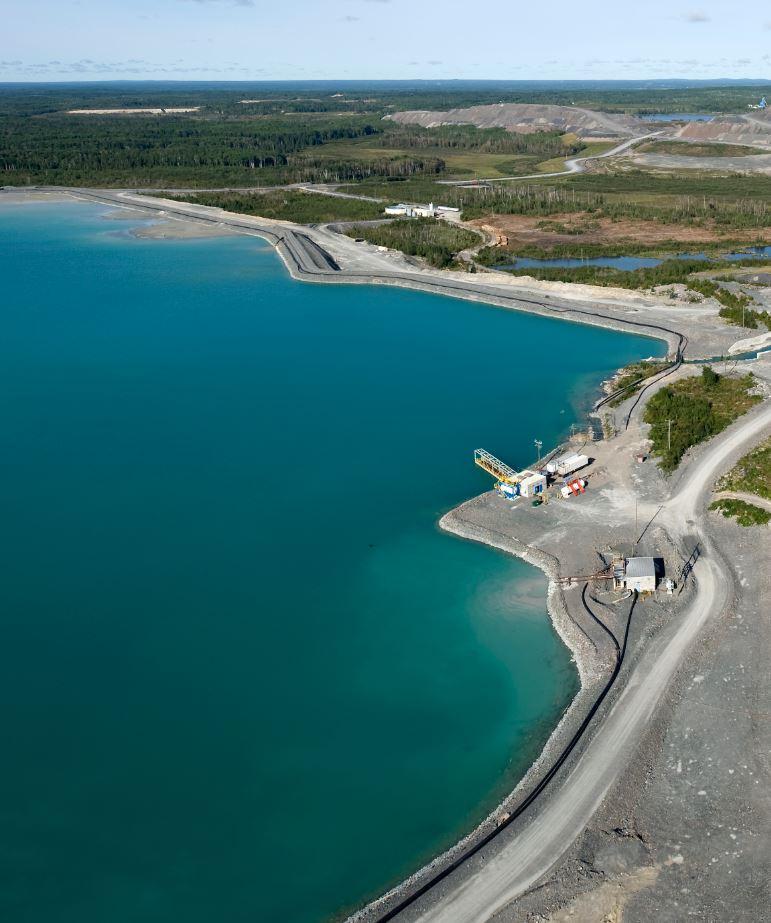Porcupine Gold Mines Reduces Fresh Water Use from Porcupine Lake to Almost Zero

As one of the oldest operating mines in Canada, Porcupine Gold Mines (PGM) has been an integral part of the Timmins, Ontario community since 1910. Part of its community commitment includes placing a high priority on water conservation and preservation to reduce its environmental impact.
In recent years, PGM has dramatically reduced its reliance on fresh water from nearby Porcupine Lake, taking important steps forward to reuse process water and help Goldcorp realize its Toward Zero Water vision.
Historically, 22% of the water used for processing ore at PGM’s Dome mill has been fresh water pumped from Porcupine Lake.
The Mill Team felt the operation could do more by reclaiming process water used at the mill. In 2012, they proposed the 100% Reclaimed Water Project to reuse as much fresh water as possible for ore processing, which would minimize fresh water intake from the lake and reduce the need to treat and discharge water from the Effluent Treatment Plant.
“Prior to this project, it was pretty much unheard of for a brownfields operation to use 100% reclaimed water,” pointed out by Gerry Stinson, PGM Mill Manager.
Recognizing that the proposed 100% Reclaimed Water Project would impact virtually every aspect of the operation, a cross-functional team was established to oversee the initiative comprised of members from the environmental department, mill metallurgical and operations groups, and the maintenance department.
“Teamwork was integral to the success of this project,” he stated. “When you look at the full spectrum of activities involved, the only way we could make this happen was by getting people from every part of the operation involved from the outset.”
The challenge involved reconfiguring the mill’s water circuit to accept 100% reclaimed water without impacting ore processing, while maintaining an accessible supply of fresh water for fire protection. Stagnant water lines would freeze in winter months if left undrained and fire protection water had to be available on-demand. For fire suppression, the team proposed a dedicated recirculation loop on the Porcupine Lake line that would return water directly back to the supply lake.
Given that fresh water for fire suppression was being returned to the watershed, the team first had to obtain an amendment to the mine’s environmental permit from the Ontario Ministry of Environment.
With this in hand, the team designed a water reclamation configuration for the Dome mill. To prove the feasibility of running the mill using only reclaimed water without any detrimental effects on ore processing, a three-month trial was conducted validating the zero fresh water concept.
Permanent modifications were then made to Dome Mill in early 2014, including new lines, valves and repurposing old water tanks. The water lines from Porcupine Lake to the mill and fire tank were updated to ensure continuous pump operation to prevent water lines from freezing in winter, and fresh water availability year-round for emergencies, such as fires.
Two refurbished freshwater tanks in the mill, with a total capacity of 800 cubic metres, are now used to store reclaimed water, with flow and levels automatically managed with flow meters and programmable control valves.
The total cost of modifications was approximately $170,000, resulting in a considerable return on investment. Once the project was up and running, average monthly fresh water use dropped by more than 100,000 cubic metres and water treatment costs declined by approximately $500,000 per year. Since the 100% Reclaimed Water Project was implemented, fresh water use from the lake per ounce of gold recovered has declined dramatically from 5.86 cubic meters in 2012 to 0.09 cubic metres in 2016.
With less water stored in the tailings pond, one less dam lift was required, saving the mine an estimated $7.5 million.
Overall, 99.6% of the water used at the Dome mill is now reclaimed, significantly optimizing water use and reducing the mine’s environmental impact.
“The intention of Goldcorp’s Towards Zero Water strategy is to push the envelope within our operations to achieve results like this,” said Stephanie Thibeault, Senior Environmental Coordinator at PGM. “This project really reflects the spirit of why Goldcorp’s Towards Zero Water initiative was developed.”
“It was a very ambitious project,” agreed Stinson. “Everyone is extremely proud of what we achieved from an operational, environmental and particularly a community standpoint.
“Porcupine Lake is a central part of the community,” he said. “Residents live on the lake and use it regularly for recreational purposes. This is a great example of how out-of-the-box thinking improved operational efficiency and reduced our water footprint for the benefit of everyone in our community.”
